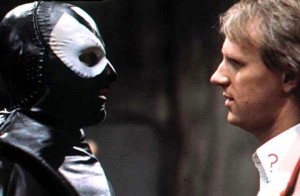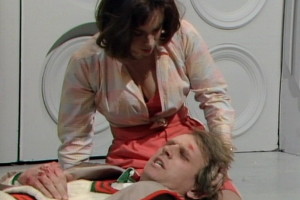 “I owe it to my friend, you see, because I got her into this— so I’m not going to let you stop me now!”
“I owe it to my friend, you see, because I got her into this— so I’m not going to let you stop me now!”
The Story:
The TARDIS lands on Androzani Minor, barely-habitable twin planet of Androzani Major, and when the Doctor decides to explore the nearby caves he and Peri are soon embroiled in a brutal underground war over control of the most valuable substance in the universe, spectrox, which can only be found in the caves. Sharaz Jek, the engineer who built the androids that work the spectrox mining and refining operation, has cut off the supply and armed his androids to kill intruders. The army has arrived to try and take back the mines, but the war has been in stalemate for months. Jek’s demand is that the government execute his former partner Morgus, who owns the mines and the spectrox, and send him Morgus head. Horribly scarred after being caught in one of the eruptions of superheated volcanic mud that occasionally engulf the caves, Jek believes Morgus deliberately supplied him with faulty warning detectors, hoping to kill him and keep all the profits of the mine for himself. We never learn for sure but he’s probably right, given the villainy Morgus gets into that we do see. Unknown to Jek or the army, Morgus is secretly behind the gun runners who supply Jek’s androids with weapons in exchange for spectrox, and he’s keeping the war going so that he can keep the price of spectrox artificially high.
The Doctor and Peri are first captured by the army who mistake them for gun runners, then by Sharaz Jek who finds Peri beautiful and wants to keep her around, then by the criminal gun runners who think they’re government agents. But they have an even bigger problem: before knowing the danger, both have stumbled into a deposit of raw spectrox. Though the valuable substance becomes a miraculous fountain-of-youth drug once refined, in its raw state it is a lethal poison and the Doctor and Peri are both slowly dying from spectrox poisoning unless they can escape and find the antidote— which lies deep in the most inaccessible part of the caves.
Review:
A few years ago Doctor Who Magazine ran one of its occasional “rate every Dr Who story ever” polls. The occasion this time was the airing of Dr Who’s 200th story. Both the top and bottom of the poll were dominated by new series episodes, since a far greater number of current fans (even among those dedicated enough to subscribe to DWM) are familiar with the new series than with Classic. But The Caves of Androzani managed to top all competition and win the award for best episode of Dr Who, Classic or new, ever. I would not put it at the very top myself (I’d name The Ark in Space for that honor) but I definitely agree it belongs in the elite rank, one of the top ten ever.
What makes its high regard among fans even more remarkable is that it is very unlike a typical Dr Who story— you might at first glance think it’s so different that fans who like Dr Who generally couldn’t possibly also like this one. But we do. There’s no world to save from an alien invasion here, there’s almost no monster (a creature talking the caves and occasionally attacking the soldiers appears a couple of times but barely figures in the plot at all). It’s the humans who are the monsters in this story.
The foreground plot is an unapologetic homage to The Phantom of the Opera, with the disfigured and masked Sharaz Jek falling in love with Peri from afar and using a secret passage to abduct her (and the Doctor) from right under the army’s nose. Jek is the closest thing the story has to a sympathetic character– but he’s clearly insane and prone to violent fits of rage, and his attraction for Peri is creepy on a level not normally seen in Dr Who. Everyone else in the story is either incompetent or corrupt, or both. Stotz, the leader of the gun runners, is a brutal criminal. Morgus is a greedy sociopath who, besides staging a war to raise spectrox prices, also has one of his factories bombed to correct an overproduction problem. The general of the army is a dimwit who believes the Doctor and Peri are innocent of gun running but will have them executed anyway rather than cause himself any trouble. The President of Androzani Major sees right through Morgus’ corruption but goes along with him for the sake of political expediency (including sentencing the population of a whole province to slave labor because of what he knows is Morgus’ manipulation of the economy). The Doctor doesn’t want to help any of these people. For once, he’s got no motive at all to become involved, and at no point in the story does he have any goal but getting Peri and himself away.
The Caves of Androzani is a tense action thriller with a surprising lack of good guys (outside of the Doctor and Peri). The cave sets are very good, black rock and dim lighting adding to the suspense. The director chooses an unusual style, using handheld cameras (or finding ways to move the studio cameras so they look hand-held) and extreme closeups to create a claustrophobic feel. Though dressed in typical Dr Who “futuristic” uniforms, the soldiers (and gun runners) use machine guns rather than sci-fi ray guns, and although any blood is kept safely offscreen you come away feeling like you’ve seen it. The performances from the guest cast are outstanding. Even the background score is a white-knuckle affair of drums and electronic screams.
The Doctor is especially good in this story, which presents the best use of the Fifth Doctor’s distinctive character out of any in the Peter Davison era. Unlike the super-heroish Fourth Doctor that came before him, the Fifth was quiet and unassuming and far less interested in rushing in and saving planets. It fits him perfectly to have him stumble into a situation where there’s no one he wants to save, so that his only concern is to get Peri and himself back out alive. At the same time, the script lets Davison show the Doctor’s strength beneath the mild-mannered persona, standing up against the brutal people he encounters and staring them down— without, as Eric Saward’s scripts often had him do— picking up a gun of his own. I can only imagine what the previous three seasons would have been like if all the writers understood this Doctor as well as this one.
Of course, this is Davison’s swan song so there’s sadly no chance to build on it. On the verge of dying from the spectrox poisoning, the Doctor finally gets an unconscious Peri back to the TARDIS. But he’s so weak he spills most of the antidote. With only enough left for one dose, he gives it to Peri before succumbing himself. The circumstances of his “death” also fit the Fifth Doctor perfectly. While his predecessor lost his life saving the entire Universe from the Master, the Fifth Doctor gives his life to save one person— not even someone he knows well, but someone he’s accepted responsibility for.
Details
- The Caves of Androzani marks the triumphant, and long-overdue, return to Dr Who of the great Robert Holmes. Holmes had not contributed a script to the series since The Power of Kroll back in the “Key to Time” season. If it wasn’t already clear, Robert Holmes’s work on this story firmly cements his reputation as the greatest writer Dr Who ever had, classic or modern.
- Eric Saward had been trying to get Robert Holmes back ever since taking over the script editor’s job, but John Nathan-Turner refused. JN-T didn’t want any of the “old guard” contributing to the series, as part of his “whole new era” idea, and was particularly obstinate with regard to a writer (and former script editor) as prominent as Holmes. Saward finally persuaded him they needed a writer with experience of the shows’ past eras to write The Five Doctors, and Holmes was briefly commissioned for that before quitting over story differences with JN-T, but the stars finally aligned here. Holmes would go on to contribute a couple of additional stories to the Sixth Doctor’s era.
 Peri is still wearing her beachwear from the last story throughout The Caves of Androzani. The combination of her halter top with bikini underneath, and the camera angle as she cradles the dying Fifth Doctor’s head in her lap, gives rise to Peter Davison’s joking complaint that his magnificently acted death scene was forever overshadowed by Peri’s cleavage.
Peri is still wearing her beachwear from the last story throughout The Caves of Androzani. The combination of her halter top with bikini underneath, and the camera angle as she cradles the dying Fifth Doctor’s head in her lap, gives rise to Peter Davison’s joking complaint that his magnificently acted death scene was forever overshadowed by Peri’s cleavage.- Like his predecessor, the Fifth Doctor sees a vision of all his companions as he regenerates. They all urge him to live, until a vision of the Master appears and tells him to die. Seeing the deceased Adric among his former friends leads to the Fifth Doctor’s last line: “Adric?” But if you want a better last line than that, what he says right before losing consciousness is “I might regenerate… not sure… feels different this time.”
- I mention above the DWM poll that ranked Caves of Androzani as Dr Who’s best story ever. They’ve done another poll since (following the 50th anniversary and Matt Smith’s departure) and Androzani has slipped to number 4. Still in the top ten, though, a position it is likely to hold for some time, I suspect. (FYI, the three stories that came ahead of it in the latest poll were The Day of the Doctor, Blink, and Genesis of the Daleks. I suspect that Day of the Doctor claimed number one only in the immediate aftermath of 50th anniversary hype and, while very good, will slip out of the top ten once things settle.)
- This story is not the season finale. For the first time since William Hartnell appeared in the first two stories of season 4, the Doctor’s regeneration does not line up with the season break.
Next Week:
“The Twin Dilemma,” 4 episodes, the season 21 finale and the 6th Doctor’s premiere.

